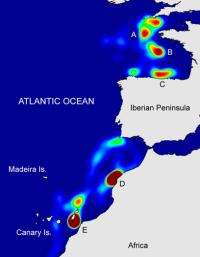Blue shark.
Scientists say the market for shark fin soup is the likeliest reason for the sharp drop in blue shark numbers over the last 30 years.
They discovered that the sharks feed in exactly the same places in the ocean that long-line fishing boats operate, which means they get caught along with other target fish.
The researchers add that such regions are ideal places to implement so-called marine protected areas, where fishing is banned, to safeguard blue sharks and other vulnerable species.
"These sharks aren't simply by-catch; we think along with mako sharks they're being targeted for the shark fin market in Asia," says Professor David Sims from the Marine Biological Association (MBA) and University of Southampton, who led the study, published in PLoS One.
"They're taking a real battering, because they're not managed. We need to get them some form of adequate protection. There's got to be a balance between conserving natural resources, and political and economic drivers," he adds.
Many shark populations have declined dramatically in the last 30 years. The blue shark – classed as near threatened on the IUCN Red List – is no exception. Its numbers have dropped by up to 80 per cent in some places since the 1980s. Mounting evidence suggests that overfishing is squarely to blame. Indeed, the blue shark is the animal most commonly reported 'accidentally caught' by fisheries operating in the open ocean.
To make matters worse, long-line fishing is up to eight times higher in the Atlantic Ocean compared with the Pacific, exacerbating the shark's plight.
"Around 60 million sharks are caught every year in the global oceans, and most are for the fin markets in places like Hong Kong and Taiwan," Sims says.
Blue sharks spend their time in regions shown in red.
Until now, there's been little detailed information about which parts of the oceans blue sharks use. This gap means conservation managers have little idea about where to focus efforts.
"The problem is that we didn't know exactly where blue sharks spend their time. Ultimately, we need this information to stand any chance of protecting them," says Sims.
He and colleagues from Portugal and the UK tracked the movements of 16 blue sharks using pop-off satellite-linked tags in two regions of the north-east Atlantic: off the coast of Portugal and south-west England.
"These regions are highly productive parts of the north-east Atlantic. They're rich in phytoplankton, which forms the base of the food chain. It's also where you find fish, and ultimately predators like sharks," Sims explains.
They found that blue sharks spend most of their time off the south coast of Cornwall, in the Bay of Biscay, and in the waters off the coast of western Africa. They typically spend their time deep underwater during the day, but emerge to spend the night in the top layer of the ocean.
International long-line fisheries use the same regions of the ocean as blue sharks.
Despite their relatively small size – about a metre to two metres long – Sims and his colleagues found that they dive surprisingly deep. They recorded a depth of 1160 metres for one individual, which is much deeper than they expected. 'It's unusual for sharks this size to dive so deep,' he adds.
"They dive down to catch squid in this perpetual midnight zone. They've got big eyes, so they can probably see animals that produce light, as some squid can," says Sims.
The researchers also noticed that the sharks hunt in the same regions of the ocean that long-line fisheries focus on.
"It's not just European fishing nations in these regions. Chinese, Taiwanese, Moroccan and Japanese fisheries ply this area," Sims points out. "They saturate shark hotspots with their long-lines, which can be 100 kilometres long."
Lines can be loaded with around 1000 hooks and operate between 100 to 300 metres deep.
"These regions happen to be the most productive areas of the ocean – where you get most fish – and where long-lining fisheries operate. They're completely coinciding with the sharks."
Sims hopes his team's data will be used to help bring in tighter regulation of the industry.
"If we don't, there's a very real risk that our grand-children won't see these sharks. We're that close to the end of the line," he says.
More information: Nuno Queiroz, et al., Spatial Dynamics and Expanded Vertical Niche of Blue Sharks in Oceanographic Fronts Reveal Habitat Targets for Conservation, PLoS One 7(2): e32374, published 29 February 2012, doi:10.1371/journal.pone.0032374
Journal information: PLoS ONE
Provided by PlanetEarth Online
This story is republished courtesy of Planet Earth online, a free, companion website to the award-winning magazine Planet Earth published and funded by the Natural Environment Research Council (NERC).






















